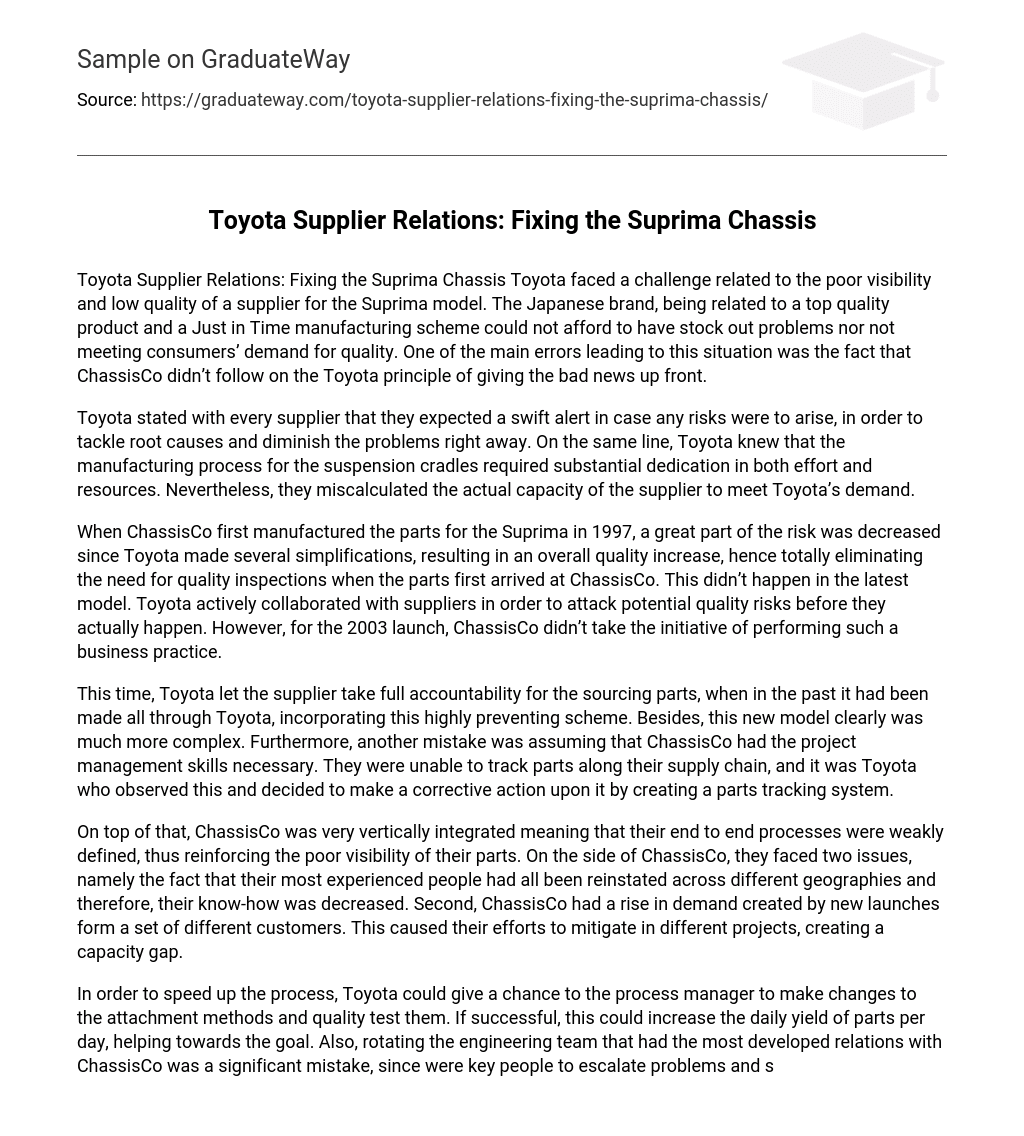Toyota Supplier Relations: Fixing the Suprima Chassis Toyota faced a challenge related to the poor visibility and low quality of a supplier for the Suprima model. The Japanese brand, being related to a top quality product and a Just in Time manufacturing scheme could not afford to have stock out problems nor not meeting consumers’ demand for quality. One of the main errors leading to this situation was the fact that ChassisCo didn’t follow on the Toyota principle of giving the bad news up front.
Toyota stated with every supplier that they expected a swift alert in case any risks were to arise, in order to tackle root causes and diminish the problems right away. On the same line, Toyota knew that the manufacturing process for the suspension cradles required substantial dedication in both effort and resources. Nevertheless, they miscalculated the actual capacity of the supplier to meet Toyota’s demand.
When ChassisCo first manufactured the parts for the Suprima in 1997, a great part of the risk was decreased since Toyota made several simplifications, resulting in an overall quality increase, hence totally eliminating the need for quality inspections when the parts first arrived at ChassisCo. This didn’t happen in the latest model. Toyota actively collaborated with suppliers in order to attack potential quality risks before they actually happen. However, for the 2003 launch, ChassisCo didn’t take the initiative of performing such a business practice.
This time, Toyota let the supplier take full accountability for the sourcing parts, when in the past it had been made all through Toyota, incorporating this highly preventing scheme. Besides, this new model clearly was much more complex. Furthermore, another mistake was assuming that ChassisCo had the project management skills necessary. They were unable to track parts along their supply chain, and it was Toyota who observed this and decided to make a corrective action upon it by creating a parts tracking system.
On top of that, ChassisCo was very vertically integrated meaning that their end to end processes were weakly defined, thus reinforcing the poor visibility of their parts. On the side of ChassisCo, they faced two issues, namely the fact that their most experienced people had all been reinstated across different geographies and therefore, their know-how was decreased. Second, ChassisCo had a rise in demand created by new launches form a set of different customers. This caused their efforts to mitigate in different projects, creating a capacity gap.
In order to speed up the process, Toyota could give a chance to the process manager to make changes to the attachment methods and quality test them. If successful, this could increase the daily yield of parts per day, helping towards the goal. Also, rotating the engineering team that had the most developed relations with ChassisCo was a significant mistake, since were key people to escalate problems and seek for solutions. Making the switch from manual welding process to an automated one actually had a negative impact on productivity.
Perhaps the root cause of this was the fact that they needed more space to install the additional capacity, but instead they decided to go for a higher plant density. Also, that they preferred the lowest bids from parts suppliers, seeking to meet the aggressive Toyota price, but instead might had jeopardized the quality of the supplied parts. In contrast to ChassisCo’s practices, Toyota actually invested time in going to the suppliers and assessing their capability. Although, by the time they did, it was already too late. ChassisCo must shift its culture towards one more compatible with the Toyota way.
This means, to escalate risks in time. Acting in such way will help solve risks swiftly and prevent further stalling of operations. Secondly, they must evaluate getting new suppliers that could in turn increase the quality and compatibility of their manufacturing processes, thereby reducing the scrap yield. Taking Toyota’s approach to meet suppliers and tune parts for an enhanced welding quality. Although the informality of these processes could be a risk itself, it could be a good solution to boost usable output if quality testing after the welding is ok.
Furthermore, ChassisCo should bring their most experienced staff in order to tackle a problem of such magnitude. In a problem of this dimension, I would call forward the best staff possible. Toyota must stop assuming that their suppliers are perfectly fit for any increase in responsibilities, especially for those suppliers from different cultures, such as ChassisCo, where they do not necessarily have the tradition of making long term relationships with suppliers nor they invest time in visiting them to anticipate risks in the manufacturing process.
To prevent this, they can document and make formal operation procedures to perform these tunings to special parts in order to enhance their efficiency. Another important point is to stay open and listen to the risks issued by the people working on the supplier side. Particularly with those risks related to a constraint in capacity or quality, such as the ones that the program manager stated earlier during the launch of the 2003 Suprima.





